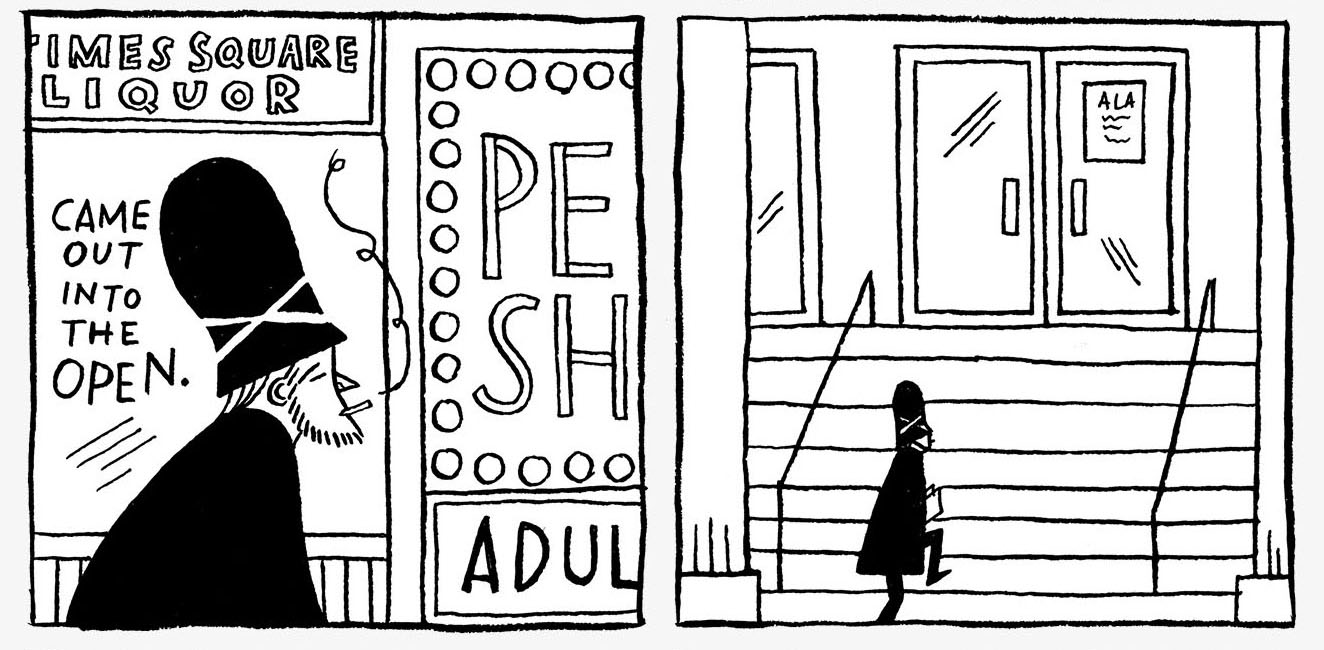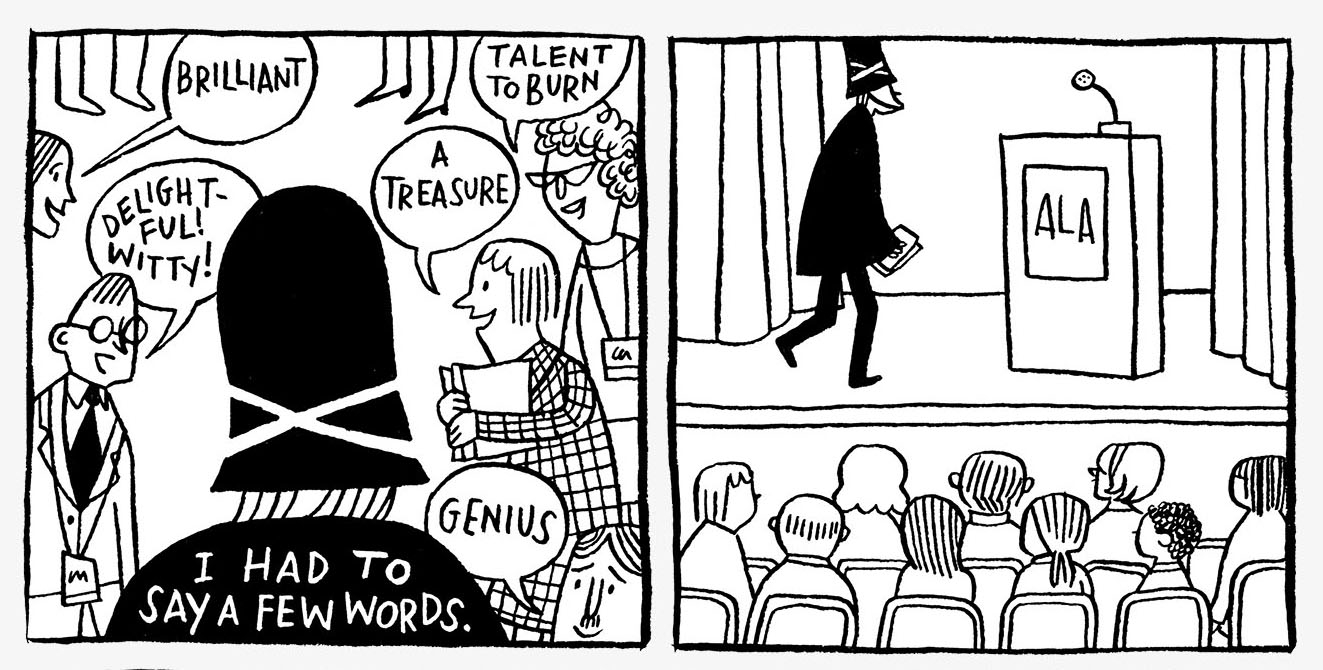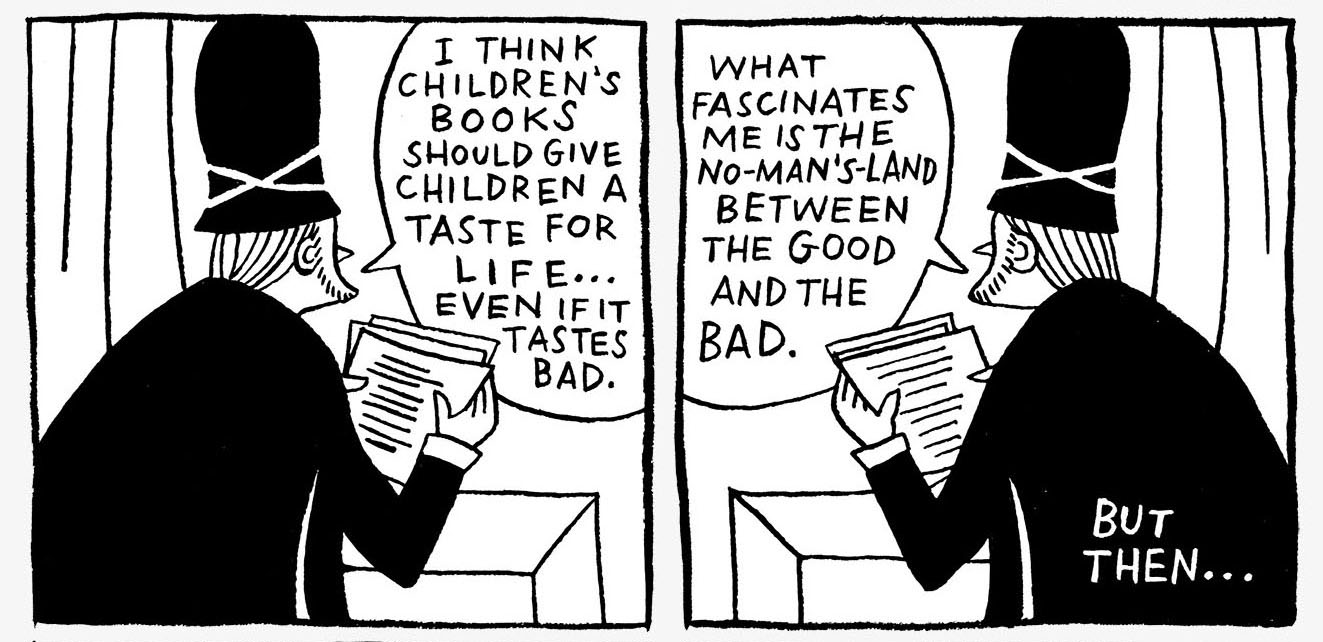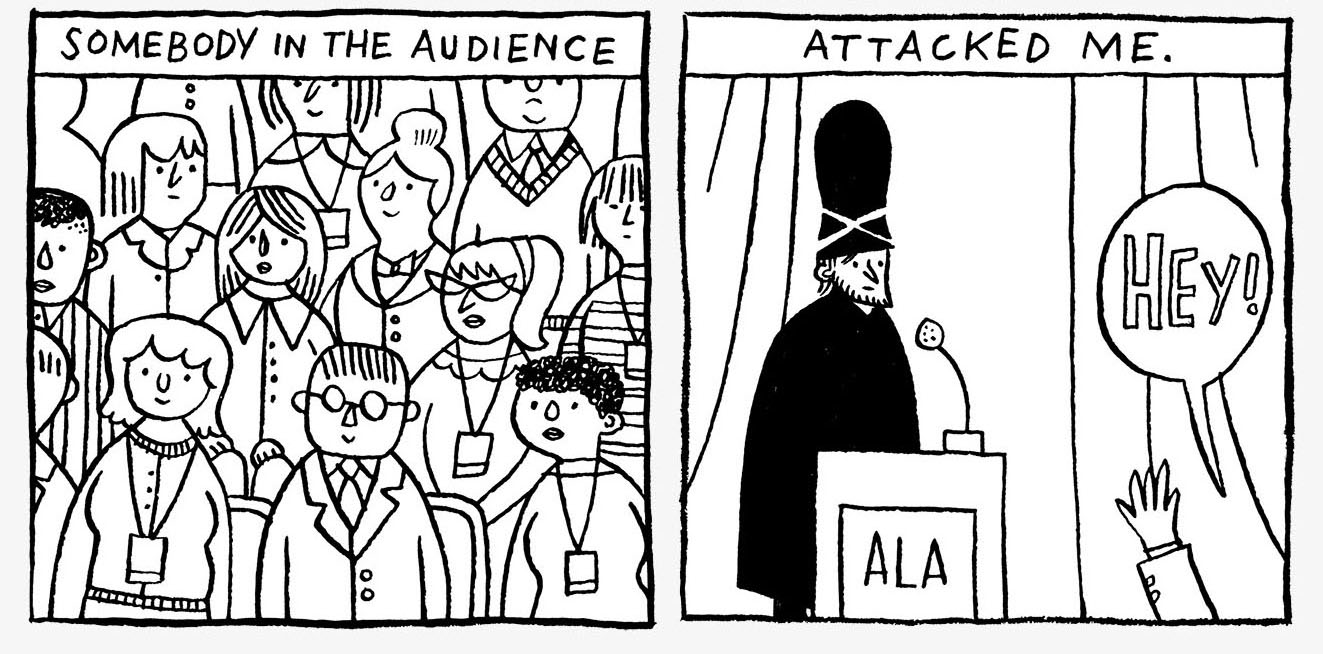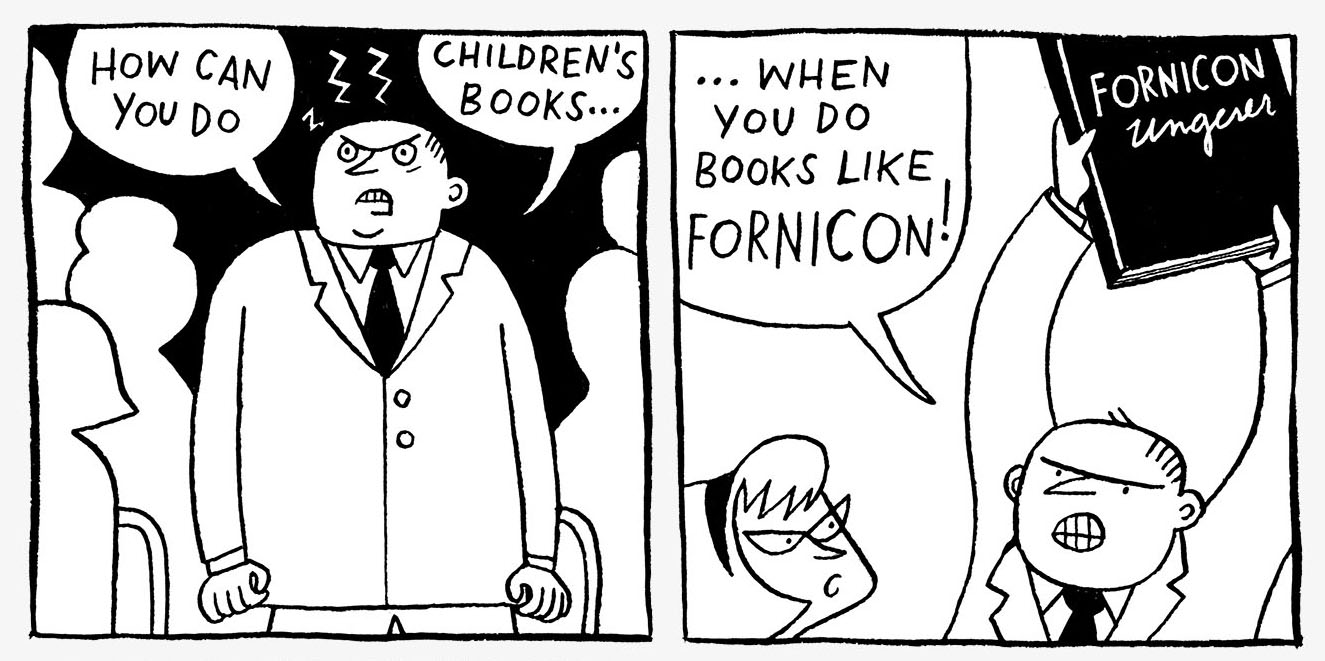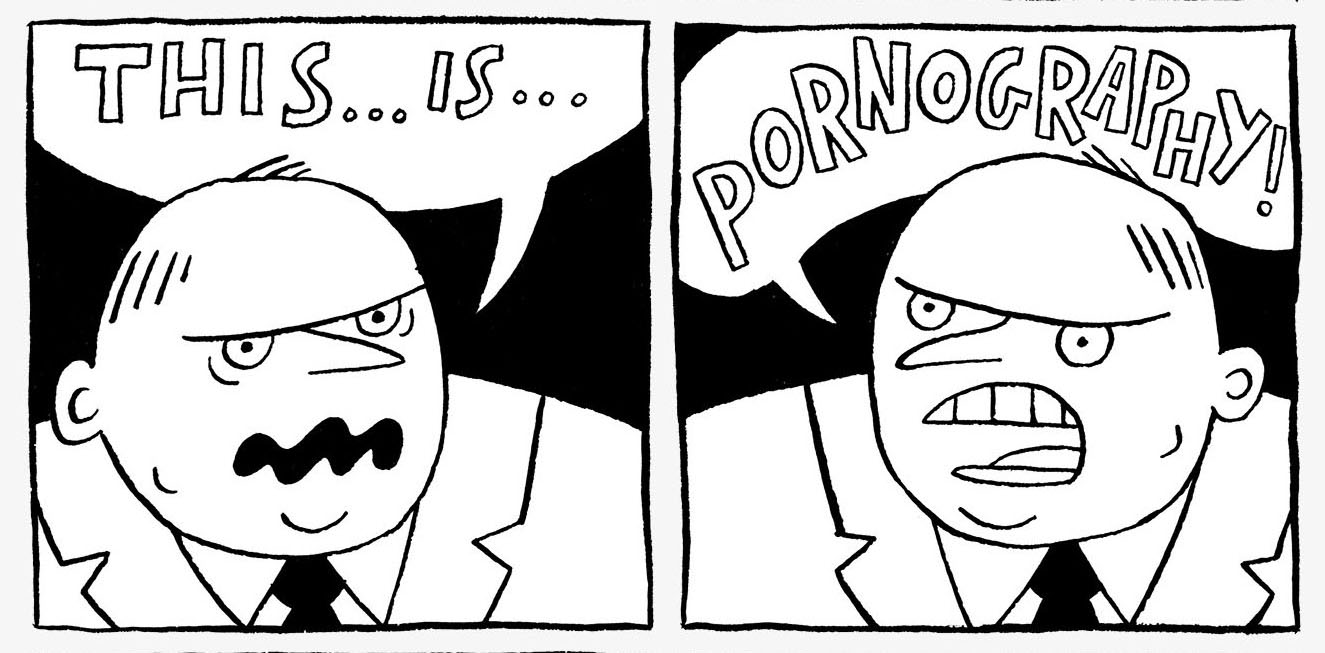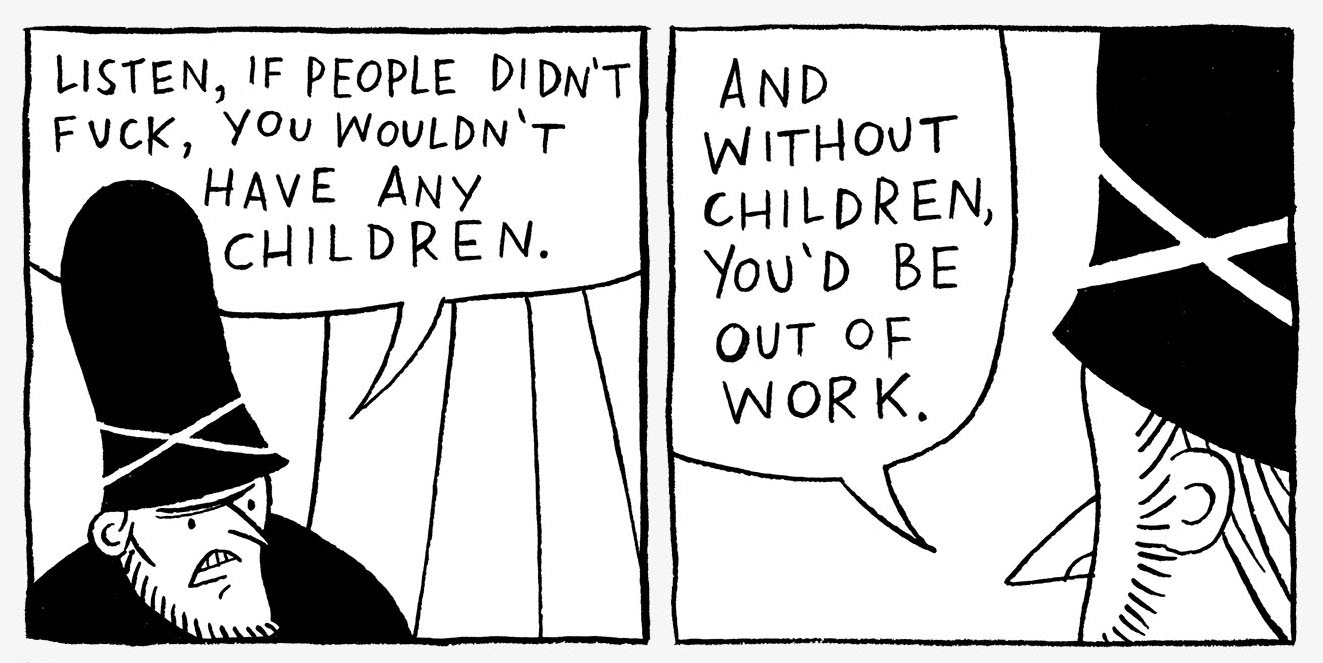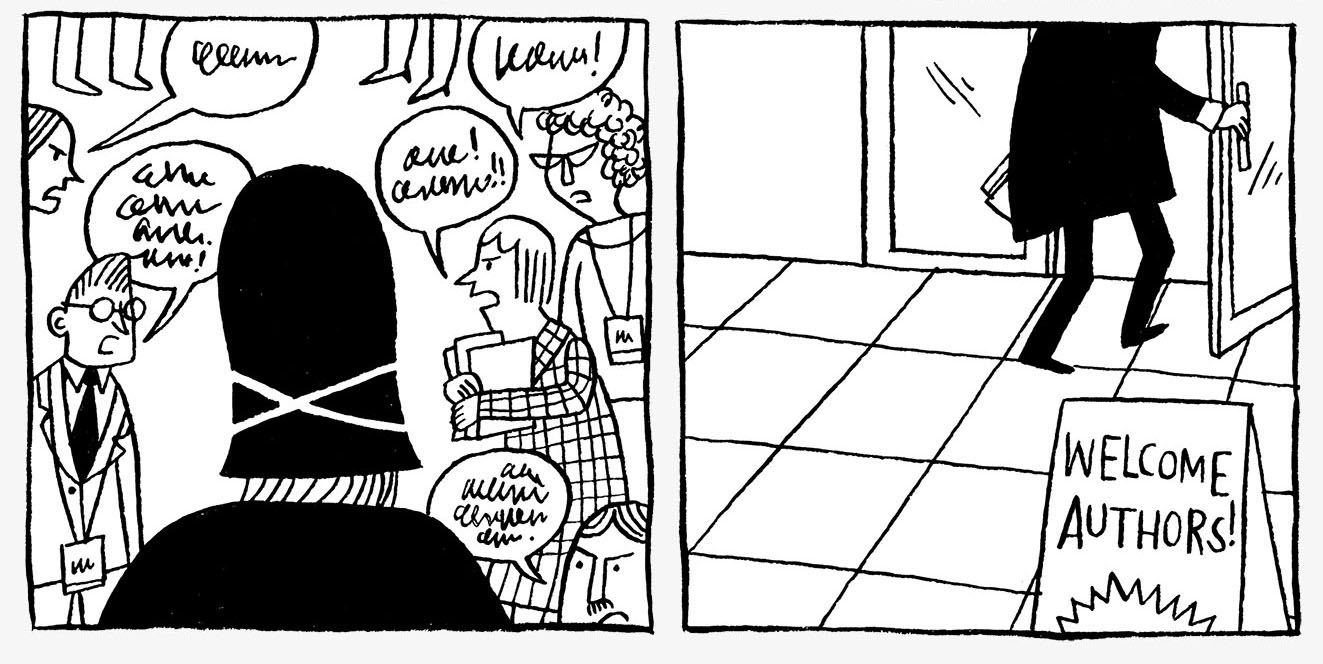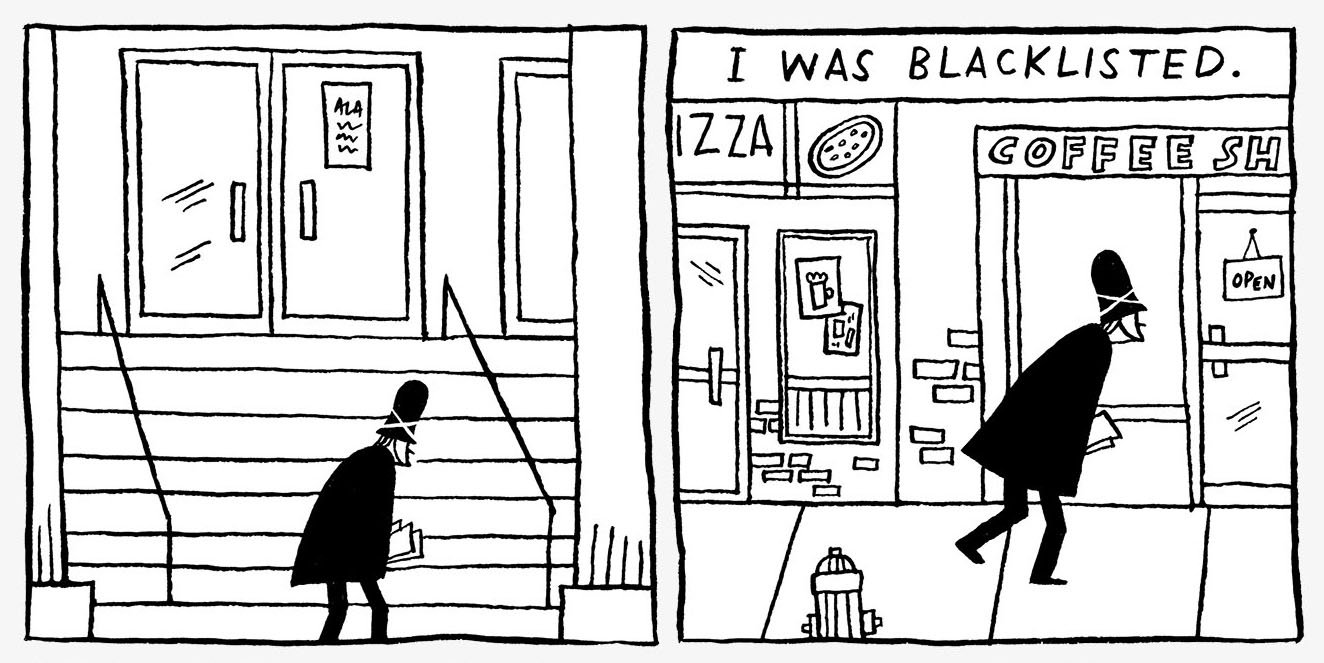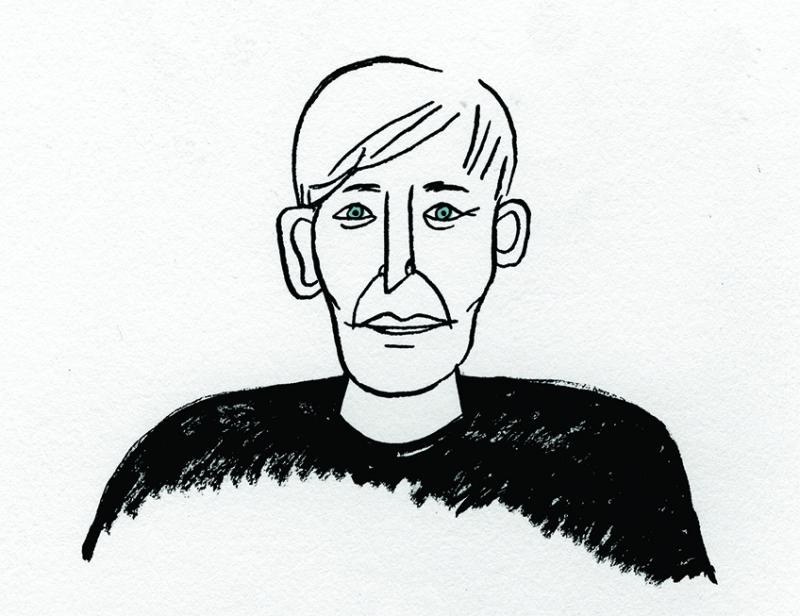 On the wall of my living room is a drawing by the late artist Tomi Ungerer. It’s of a bearded man in medieval garb clutching a book and an enormous knife. He’s grinning wickedly at a child screaming in a boiling cauldron, heated by a pile of burning books. The piece is for the cover of a children’s-book exhibition catalog from 1965.
On the wall of my living room is a drawing by the late artist Tomi Ungerer. It’s of a bearded man in medieval garb clutching a book and an enormous knife. He’s grinning wickedly at a child screaming in a boiling cauldron, heated by a pile of burning books. The piece is for the cover of a children’s-book exhibition catalog from 1965.
Ungerer died in February 2019 at the age of eighty-eight, and I’ve been thinking of that drawing, and of the artist, ever since. In the past decade or so, I’ve become an acolyte of Ungerer, drawn not only to his work but also to the story of his life, his career, and his unique personality—now more than ever.
Ungerer was tall and thin, with a Gallic nose, a mouthful of crooked teeth, and, for a considerable time, a Lincoln beard. He was born in Strasbourg, in Alsace, a historically contested region on the border between France and Germany, and spent much of his own childhood similarly pulled apart. Under four years of Nazi occupation, he was forced to speak German instead of his native French, and was subjected to endless doses of Third Reich propaganda. After the liberation, he was denigrated for his German accent and forbidden to speak Alsatian in school. To be an Alsatian, then, meant that you were condemned to live in a kind of linguistic and cultural no-man’s-land. It’s no wonder he felt compelled to leave.
In 1956 he booked passage on a Norwegian cargo ship headed to New York City, arriving with sixty dollars to his name and a deep love of American literature and culture. He soon began hawking his wares among New York ad agencies and publishing houses, visiting art departments with drawings he kept in a large cardboard box that had formerly contained wholesale condoms. His hustle paid off: Within a few years, his work could be found on event and movie posters, in popular magazines like Esquire, Harper’s, and Life, and in advertising campaigns for the likes of Chiquita bananas and the Village Voice. He published books of satire and exhibited in galleries. He created piece after piece of virulently antiwar and pro–Civil Rights poster art. And he wrote and illustrated children’s picture books.
For Ungerer, creating children’s books was a passion, but the business of children’s literature in the 1950s was generally sentimental and moralistic. Luckily, editor Ursula Nordstrom, of Harper & Brothers, was in the process of changing the tenor of the industry. Ungerer had been told that Nordstrom, who had published such unique voices as Margaret Wise Brown, Edward Gorey, Ruth Krauss, Maurice Sendak, and E. B. White, was the only editor in town who would dare take on his work. The first story he pitched—about a family of pigs kidnapped by a determined butcher—was too macabre even for her. But the pig family was adorably appealing, and thus became the protagonists of his first published book, The Mellops Go Flying, which won honors for the debut creator.
 The accolades kept coming. Between 1957 and 1973, he published more than twenty books for children—most of them with Nordstrom—earning him a string of awards and a dedicated following among young readers. He was a kid-lit superstar, and rightly so. His simply rendered line drawings were both playful and sophisticated—like Saul Steinberg for the kiddie set—and his offbeat fairy-tale-like narratives spoke to the nonsensical nature of the human condition. Best of all, his books were incredibly fun to read.
The accolades kept coming. Between 1957 and 1973, he published more than twenty books for children—most of them with Nordstrom—earning him a string of awards and a dedicated following among young readers. He was a kid-lit superstar, and rightly so. His simply rendered line drawings were both playful and sophisticated—like Saul Steinberg for the kiddie set—and his offbeat fairy-tale-like narratives spoke to the nonsensical nature of the human condition. Best of all, his books were incredibly fun to read.
Some reviewers thought otherwise, and criticized his books for being naughty and “unremittingly negative,” littered with adult material (smoking, drinking, blood and guts) while prioritizing a world of fear. In a New York Times review, Noel Perrin matter-of-factly highlights Ungerer’s work as “on the whole sadistic,” combining “sick humor and visual wit” with “touches of thinly concealed cruelty.” I suspect that Ungerer, who boasted of being “the nightmare of all the pedagogues,” welcomed such descriptions. In 2011, he told New York Times Book Review editor Pamela Paul that “[people] think children should be loved and protected. But if you do only that, they’re not ready for life.” Instead, he claimed, archly, that children “should be traumatized.” Saccharine tales of “bunny rabbits and lettuce leaves,” as Sendak put it, were anathema to him because they simply weren’t interesting. He preferred to include images of commonly reviled animals such as vultures and bats, or of violence, such as a drawing of a man stabbed in the head with an umbrella. (Years after publishing The Beast of Monsieur Racine, which features that umbrella-punctured victim, Farrar, Straus and Giroux was still fielding complaints about the book’s sly depictions of gory wickedness.)
Want to know what is interesting? A blunderbuss. In Ungerer’s masterpiece of a picture book, The Three Robbers, there is a blunderbuss, a pepper-blower, and an axe, all of which are wielded by bandits as they terrorize the countryside. Could that be what Perrin meant by “thinly concealed cruelty”? What about the ogre in Zeralda’s Ogre, whose modus operandi is eating human flesh? Or the irreverent and somewhat queasy illustrations for William Cole’s poetry anthology Beastly Boys and Ghastly Girls—a lion in the act of devouring a unicorn, and a smiling little girl being whipped by a Victorian-looking gentleman (an image with which I was obsessed as a kid)? Even Crictor, Ungerer’s award-winning book about a French schoolmarm and her heroic pet snake, contains a masked robber, guns, and an illustrated scene of the madame tied up and gagged. Then again, Crictor, upon its release, was criticized simply for being about a snake.
Plenty of scholars and critics have speculated that Ungerer’s childhood trauma under the Nazis led to his need to explore dark themes in his books. Perhaps, but blood, guts, and danger can also just be, well, fun. And funny. Life is complicated, nonsensical, and ultimately disturbing. Children know this; they experience it in spades, all the time, whether it’s having to eat a food they hate or something much more deeply serious. My own, clearly Jewish way of dealing with horror has been to focus obsessively on it, then joke about it. For myself, as for many others, stories that make you uncomfortable, scared, and sad are the most interesting stories there are. Tomi Ungerer wrote those kinds of stories, and they were beloved.
And then, in June 1969, something happened. Let’s let Mr. Ungerer tell the story himself.
After that conference, the story goes, Ungerer was persona non grata in the world of American children’s books. The “multiple activities” he mentioned may have included his activism or his satirical books for adults, but they most certainly referred to his so-called pornography.
At the same time that Ungerer was racking up awards for his picture books, he was happily holed up in his studio in then-seedy Times Square, dismembering and reassembling Barbie dolls in disturbing new configurations and making countless erotic drawings, often with a sadomasochistic bent. Some of these drawings were collected in Fornicon, first published by Diogenes Verlag in 1969 and dedicated to the “mechanization of sex” (its pages include women literally bending over backward to have sex with priapic machines). The book was considered to be such a shocking compendium of depravity that, to the apparent delight of its author, it was banned in the United Kingdom.
The 1969 American Library Association (ALA) conference was supposedly the first time that American librarians were made aware of Ungerer’s erotic oeuvre. The result was, in Ungerer’s telling, horrible: His children’s work was tossed out of American schools and libraries, full stop. His friend Burton Pike, in the documentary film Tomi Ungerer Versus America, says that “[the incident] torpedoed Tomi’s real fame and success in this country. The reaction was quite strong.” Ungerer himself claims that his books were “officially banned from all public libraries.”
Despite the story he told over the years, there’s no concrete evidence of an institutional mandate to remove Ungerer’s books from libraries. It is true that mentions of his work in the New York Times—then, as now, the arbiter of what books to read and buy—became scarce by the mid-1970s; reviews of his last children’s books, meanwhile, ran alongside those of adult titles. After that, Ungerer didn’t publish his own book for children until 1997, with Flix, the poignant and funny but slightly obvious allegory about a dog born to cat parents.
Although there was no official industry resolution against his work, the result was essentially the same as if there had been. Sendak, who by then had become a close friend, stated that after Ungerer’s adult work was exposed, he “was not welcome anywhere in the children’s publishing world…we had no way to help him. To be a Tomi-ite—you were on the wrong side.”
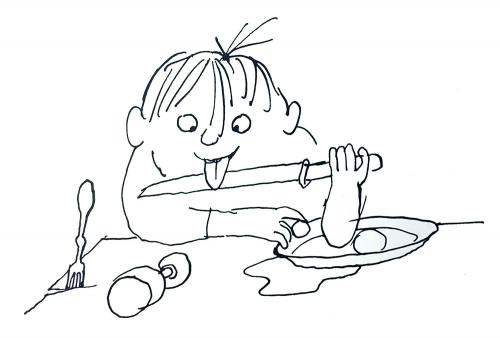 So he left that world, left the United States itself, much like he had left his home in 1956, moving with his wife to remote Nova Scotia, then to rural Ireland, and never moving back. “It was time to go,” he says wistfully in Far Out Isn’t Far Enough, the 2012 documentary about his life and work. “Time to go.”
So he left that world, left the United States itself, much like he had left his home in 1956, moving with his wife to remote Nova Scotia, then to rural Ireland, and never moving back. “It was time to go,” he says wistfully in Far Out Isn’t Far Enough, the 2012 documentary about his life and work. “Time to go.”
Despite Ungerer’s exit from American publishing, he nonetheless continued to be published widely in Europe. He received numerous awards in the years that followed, including Germany’s Order of Merit in 1993, the Hans Christian Andersen Award—the world’s most prestigious award for children’s literature—in 1998, and the Légion d’honneur in 2018. He had a one-man show in the Louvre in 1981. In 2007, a museum dedicated to his life and work opened in his hometown of Strasbourg. Europe, it seems, relishes Ungerer’s wickedness.
Would that I had grown up there instead of in the States. As a child in 1970s New York, I read every picture book I could get my hands on, and yet I barely knew about Ungerer’s books. The only ones I recall reading as a kid were Crictor and the fabulous Beastly Boys and Ghastly Girls. Others—Rufus, Orlando, The Brave Vulture, even The Three Robbers (his greatest book) just couldn’t be found. I consider this a travesty. I was a relentlessly morbid kind of kid who would have cherished the darkness of his pictures. They would have scratched that macabre itch. Ungerer’s books remained missing, for the most part, from American shelves until Phaidon, primarily an art press, republished them in 2009. (Fantagraphics, an alternative-comics publisher, is republishing his adult works The Underground Sketchbook, The Party, Babylon, and Adam and Eve this fall.)
In the United States, librarians have always had undeniable power over which books get traction and therefore stay in print, particularly in the children’s-book world. And the ALA is the organization with the most influence over US librarians, who, in their professional capacity, purchase more books than any other group of literary consumers. Without their support, Ungerer’s books went out of print for twenty-some years and were eventually removed from circulation.
The discovery of Ungerer’s erotic work couldn’t have been the only reason he was shunned; his politics surely played a role. His anti–Vietnam War posters, for instance, were so shockingly violent—one depicted a disembodied arm, with the word eat on the sleeve, shoving the Statue of Liberty down a crudely stereotyped Vietnamese man’s throat—that Columbia University, which had commissioned them in the first place, refused to put them up. His pro–Civil Rights posters were equally brutal: A famous one depicts a black man and a white man devouring each other.
And then there was his behavior. Sendak describes Ungerer as “not respectable at all,” and “oozing personality.” There were stories of him attending the sort of raucous parties in East Hampton that might seem more fitting for a hedonistic rock star than a children’s-book artist. Even among that crowd, he was notorious, firing his Winchester rifle over the heads of other guests and sneaking into empty, well-appointed homes to bed down for the night.
Despite his behavior, or perhaps because of it, most people with whom Ungerer socialized adored him. There is often, of course, something incredibly attractive about someone who is so unapologetically and wickedly impious. Author and publisher Jeanette Seaver, who knew Ungerer in the 1960s and early ’70s, said he was charming and “very open-minded, generous, funny, [with a] huge sense of humor,” admitting, too, he was often “dark and devilish.”
“We loved him for his wild imagination,” said Toby Talbot, author and cofounder of Lincoln Plaza Cinemas. Steven Heller, former art editor of the New York Times Book Review, described it like this: “What Tomi was doing was just expressing his innermost. And that innermost was funny, that innermost was poignant, and, at times, that innermost was quite gross.”
Ungerer’s editors had to be vigilant lest his funny, gross innermost make its way into his picture books. Phyllis Hoffman, a former editor at Harper & Row, was quoted in Ungerer’s obituary in Publishers Weekly as saying that she “had to check every page very carefully because Tomi loved to put erections on the men or even the boys in the pictures.” Another of his editors, Susan Hirschman, says that “one had to look very carefully if there was a beach scene to be sure there weren’t condoms lying around the beach. He was naughty and happy to be naughty.”
Sometimes his innermost was more snide than funny. In a number of articles, Ungerer had confessed to being “a misogynist, basically.” Of course, even if he hadn’t said so himself, his erotic and satiric work would probably lead to that conclusion anyway. His penchant for drawing leather-clad women—tied up, on their knees, asses in the air—could be seen as just another example of objectification. And yet Ungerer qualified his misogyny, saying in Comics Journal that “the women and men I depicted in my work were always the kind of women and men I did not like. This gives the impression of being a misogynist.” Maybe he’d confused the word “misogyny” with “misanthropy.” Or, more likely, he was just using the word to be provocative.
His sexual provocations weren’t limited to his work, either. He boasted of a woman offering herself to him as a sex slave, an offer he gleefully accepted; he spoke of his sexual tastes without shame—indeed, sexual freedom was important to his worldview. His actions show a man dedicated to sex positivism, feminism, and the respect and acceptance of all sorts of consensual sexual expression, no matter how kinky. This is someone, after all, who spent time interviewing prostitutes and dominatrixes in Hamburg about their lives and work, and who petitioned for their métier to be legalized and legitimized in order for them to gain full rights and protections. He spoke at length about respect, equality, and reproductive rights, and was active in the fight against AIDS in the early 1990s, distributing condoms adorned with his drawings. The reviled Fornicon is, in a sense, a feminist manifesto: Who needs men, after all, when one can have machines do the job so much better?
Librarians in the late 1960s were horrified by Ungerer’s adult work and uncomfortable with the knowledge of his personal penchants. Maybe that was enough to throw him out of their world or for him to have been, in the parlance of today, “canceled.” But here’s what I’m really trying to get at: I’m not sure that they would have been so angry if they didn’t, on some level, hate his work to begin with. Their anger at his life and adult work was a wonderful excuse to get rid of his children’s books under the inane reasoning that his erotica might harm an unwitting child, no matter that it was patently ridiculous to think that children would get their hands on his work for adults or even understand it if they did.
Ultimately, it’s clear that at least a handful of adults felt that Ungerer was getting away with something. He was putting these children’s books out there that were filled with uncertainty, psychological exploration, and playful rage—often to no visible pedagogical purpose. His books were firmly in opposition to a literalist view of children’s literature, where there is no room for satire, no room for artistic license or uncertainty, a view that insists that everything a child observes is a blueprint for action. If you see a blunderbuss, you will shoot a blunderbuss.
There are plenty of adults—even librarians, who in my opinion should know better—who are convinced that certain books can be harmful to a child. Woe betide a kid who opens up Fornicon to a picture of an obscene machine, or reads a children’s book that admits the existence of sexuality or violence. Or even anatomical detail. In Sendak’s 1970 book, In the Night Kitchen, a picture-book tour de force, the main character is a little boy who “[falls] out of his clothes” and remains nude for most of the story, including one scene where his nudity is unabashedly full frontal. (Sendak would go on to do the same thing again in an illustration for Randall Jarrell’s Light Princess, this time for an infant girl, to no apparent concern.) In the Night Kitchen made more than a few librarians blush, and prompted some of them to independently, and to the lasting horror of Sendak himself, paint diapers over the offending anatomy. This mindset is, fascinatingly, still prevalent. While adults in the 1960s painted tighty-whities on Sendak’s Mickey, their counterparts in the 2010s pushed Dav Pilkey’s Captain Underpants series near the top of the ALA’s Office for Intellectual Freedom’s Top Ten Most Challenged Books list as recently as 2018 because of, among other things, “partial nudity” (a.k.a. underpants).
Beyond their books, the private lives of children’s bookmakers was also reason for censure. Beloved picture-book creators including Tomie dePaola, Arnold Loebel, Remy Charlip, James Marshall, and Sendak himself couldn’t come out of the closet because it would have destroyed their careers in children’s literature. The late, great, middle-grade author Richard Peck didn’t reveal his homosexuality until 2016. Not long afterward, his last book, The Best Man, which features a same-sex wedding, was removed from a school bookfair in Georgia because of its homosexual content.
While most people in the book industry today don’t balk at homosexuality, the personal and sexual lives of creators are still cause for controversy. This is especially true of contemporary children’s authors and illustrators whose work is popular but unsettling. Sherman Alexie’s National Book Award–winning novel, The Absolutely True Diary of a Part-Time Indian, has steadily come under fire and been banned for its discussion of masturbation, depictions of alcohol use, and use of profanity. Last year, several women accused Alexie of “trad[ing] on his literary celebrity to lure them into uncomfortable sexual situations.” Reasonable people can disagree about the tenor, accuracy, and seriousness of these allegations, but they seemed to have managed to remove his work from some schools and libraries more successfully than any banned-books list. Similarly, Jay Asher’s enormously popular Thirteen Reasons Why has been challenged for romanticizing teen suicide, but it was accusations of inappropriate extramarital affairs at literary conferences that made him an outcast in children’s publishing, sparking a very visible social-media push among librarians and teachers to remove his books from their collections and reading lists. My husband, Lemony Snicket (Daniel Handler around the house), has also rankled some gatekeepers with his dark and subversive work. A recent call for his cancellation included a complaint about his reading aloud from a sex scene in a Pulitzer Prize–winning novel while on an ALA panel.
There are obvious parallels here to what happened to Tomi Ungerer. Like Ungerer, these authors’ interactions in the adult sphere have been especially scrutinized and criticized. And, like Ungerer, their work for children was controversial to begin with. Could it be that the criticism of these artists’ writing for children and the condemnation of their private lives are being used to the same end, to get rid of their books? It’s an unsettling question, but one worth asking.
As a children’s-book creator, I know that there is a prevailing mandate for us to conduct ourselves according to a higher standard than other artists, or even than other people. In a January 2019 New York Times opinion piece, Judith Shulevitz came out strongly against “morality clauses” in publishers’ book contracts, in which an author’s book is at risk if the author becomes involved in “complaints or scandals.” But she makes an exception for children’s publishers, who “have a case.” “It would be challenging to sell a children’s book written by a pedophile,” she says, apparently thinking that a pedophile who wrote, say, a biography, would have no such obstacle. I’m trying to imagine Ursula Nordstrom including a clause in Ungerer’s contract that ensured she could cancel his books if it ever came to light, say, that he had shot a gun at a Hamptons shindig or showed pornographic movies to guests at studio gatherings.
An anonymous author complains in Wild Things! Acts of Mischief in Children’s Literature by Betsy Bird, Julie Danielson, and Peter Sieruta that children’s authors and illustrators “must themselves be well-behaved children.” Of course, Ungerer was not a well-behaved child, not even when he was a child. In school he was described by a headmaster as a “willfully perverse and subversive individualist,” and he remained so for his entire life. And, naturally, he put those characteristics into his books.
I’ve been wondering why children’s-book creators have to be judged against purity: why they have to be both perfectly well-behaved in their personal lives and in their work for children. I want permission for children’s books—and their authors—to be left alone to embrace an artistic tradition of mischief and psychological exploration. Children’s-book creators are artists, after all, same as any fine-art painter or literary novelist.
Librarians and others who try to squelch that impulse and deny the literary bona fides of artists to create those kinds of iconoclastic books—which, by the way, kids adore—are missing an important piece of what makes literature great. I am a full-throated champion of books that inform and bring awareness to history, identity, and other issues of educational import—but kids also need books that speak to their fear, rage, idiosyncrasies, and humor. It is unsurprising that many of those books have been created by artists who exhibit those same tendencies in their own lives.
What happened to Tomi Ungerer has happened over and over again, even in today’s supposedly more liberal climate. Plenty of adults still worry that literature will literally harm children. If a book has descriptions of drugs, kids will do drugs. If it has sex, kids will have sex. A book that fails to explicitly endorse contemporary political ideals or appropriate language can be profoundly damaging. Even a drawing of a gun, a cigarette, or a pair of underpants can be harmful.
In other words, it seems to be the case that, for certain adults, not only does the content of children’s books serve as instruction for what to do and how to live, but so do the actions of the creators themselves. This point of view has prompted people to declare that they won’t consume books by authors whose lives they disapprove of in one way or another. That is, of course, their choice. But when librarians use the same criteria to keep books out of circulation, or teachers withhold those books from their classes for the same reason, these works of literature, arguably important in their own right, might never make it into the hands of kids who might adore them. And that idea is incredibly disappointing, if not an actual disservice to young readers.
In 2011 there was an exhibit of Ungerer’s work titled Tomi Ungerer, Chronicler of the Absurd at the Eric Carle Museum in Amherst, Massachusetts, a museum dedicated to children’s-book art, in honor of Ungerer’s eightieth birthday. The drawing I own was there. In a scene in Far Out Isn’t Far Enough, Ungerer walks through the exhibit gallery, looking at his past work. He stops at the illustration and reads the title: “Ogre burning books and boiling child.”
He adds: “Well, I’m sure the child deserved it.”



